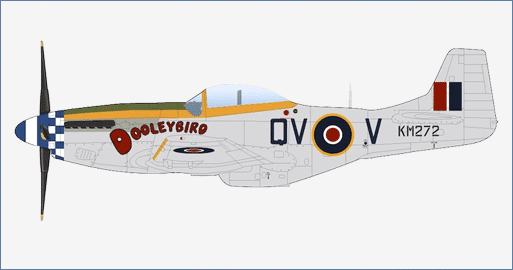Air Power Series>1:48 die-cast display model>P-51>HA7749
Mustang Mk.IV "Dooleybird" flown by F/L Arthur S. "Joe" Doley, 19th Squadron, RAF, late 1945

General Background
Later in WWII the Allied bombers were flying deep into Germany but suffered tremendous losses because of the lack of range the fighter escorts had. German fighters would wait beyond the range of the Allied fighters and then attack the vulnerable bombers. Once the P-51 called Mustang by the British had the Allison engine replaced with a British Merlin it possessed the high performance that had been lacking. With drop tanks the P-51 had the range to escort bombers all the way to Berlin and back.
The Aircraft
During WWII F/L Arthur S. “Joe” Doley flew Spitfires and Hurricanes with the Nos. 610 and 87 Squadrons of the RAF. In February 1945 he transferred to No. 19 Squadron flying P-51 Mustangs on long range operations over the North Sea. Over time salt would make the aircraft look worn so Doley’s Mustang was sent for an overhaul and replaced by a new natural metal Mustang Mk.IV KM272 / QV-V. Doley had “Dooleybird” painted on the left side of the fuselage along with a blue and white spinner and engine cowling.
Specifications :
Tasks: |
Dive-bomber, bomber-escort, ground-attack, interceptor, photo recon |
| Number Produced All Variants: | 14,819 |
| Dimensions | |
| Height: | 13 ft 8 in (4.16 m) |
| Wingspan: | 37 ft (11.27 m) |
| Length: | 32 ft 3 in (9.82 m) |
| Weight | |
| Empty: | 7,125 lb (3,232 kg) |
| Gross: | 10,100 lb (4,581 kg) |
| Maximum Take-off: | 11,600 lb (5,262 kg) |
| Performance | |
| Engine: | Packard Merlin two-staged supercharged V-1650-7, 12 cylinder V engine 1,695 hp. |
| Maximum Speed: | 437 mph (703 km/h) |
| Ceiling: | 41,900 ft (12,771 m) |
| Range: | 950 miles (1,529 km) |
| Maximum Range: | 2,300 miles (3,701 km) |
| Armament | (6) .50 caliber MG |
| Maximum External Bomb Load – 2,000 lb (907 kg) | |
| Or (4) .5 inch rockets |

